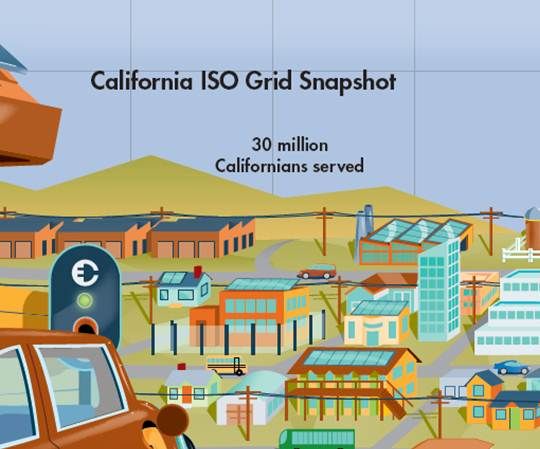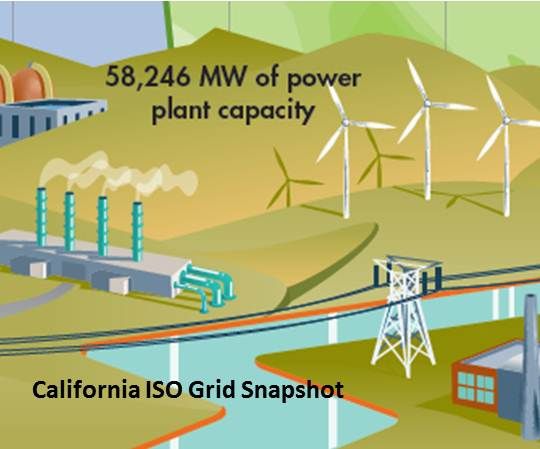Building enough new solar and wind capacity to meet California’s 33 percent renewables by 2020 mandate will not be easy -- but reliably getting the electricity generated by those resources to the places where it will be consumed may be even tougher. That is the responsibility of the California Independent System Operator Corporation (ISO).
The ISO has just released a five-year strategic plan that lays out what needs to be done in four steps.
First, according to the ISO’s CEO Steve Berberich, “We’ve been working on -- and will continue to work on -- our support of the state’s ambitious energy and environmental goal of 33 percent renewables.” The ISO, Berberich said, has “been doing studies to find out how much capacity we need on the system and how much ramping we will need when the sun doesn’t shine and the wind doesn’t blow.”
It is also working to make sure California has a reliable, cost-effective transmission system with adequate interconnections. Berberich said the ISO hopes to control costs by efficiently interconnecting new transmission with existing lines so as to rationalize development. The newest iteration of the ISO’s annual transmission plan proposes 29 new “reliability-driven transmission projects” at a cost of $647 million. That would add to the state’s $10.5 billion, 545-project transmission buildout, ongoing since 1998.

Second, Berberich said, is making sure the ISO has enough non-renewable generation. “What we’re going to find with the generation we have now,” he explained, “are three forces acting on it.”
First, traditional generators are going to be selling less electricity as more renewable capacity is added. Second, there will be excess capacity between 2012 and 2017. And third, between 2017 and 2025, about a quarter of the conventional generation will be retired.
Less well known than the 33 percent mandate is California’s requirement that, as of 2017, power plants using coastal and estuary waters for cooling be retrofitted, repowered or retired. The state’s two nuclear plants have until 2024 to do this. This affects 11 natural gas plants providing 12,000 megawatts of capacity on the ISO grid.
“It takes five to seven or more years to develop a generator,” Berberich said. “When you look out to 2017, you don’t have a lot of years left.” To back up renewables, the conventional fleet must be as clean and as little used as possible, Berberich said, “but it has to be there." He added, "we have to act now to keep the capacity on the system.”

The third strategy, Berberich said, is to make sure state agencies, especially the California Public Utilities Commission (CPUC), the California Energy Commission (CEC) and the ISO, can “connect the dots.”
One example of connecting dots is demand response. “If we had a vibrant demand response program here in the state, I would make sure it was in our assumptions. But we don’t,” Berberich said. “It’s up to the CPUC to get it launched, [along with] energy efficiency. And electric cars -- how do we make sure they charge at night as opposed to the middle of the day?” If state agencies don’t "connect the dots" on these issues, the ISO’s only alternative is new capacity, Berberich explained.
Fourth, Berberich said, is collaborating with adjacent balancing areas to take the strengths that each has to offset weaknesses. Giving the ISO access to less costly out-of-state renewables could stimulate a healthy competition. And access to unused out-of-state conventional generation could help balance California’s variable renewables. Both options, he said, “could provide value to the ratepayer.”
Though Berberich stressed that the ISO is building all the capabilities necessary to smooth the addition of variable renewables, it was clear the supply of conventional generation looms large for him. “Assuming marginal load growth as the economy grows,” he said, “and taking out all the once-through cools, except the nuclear units, you have approximately 4,600 megawatts of ramping resources that you need by 2020.”
The flexibility offered by conventional thermal capacity, Berberich said, becomes progressively more vital as the ISO integrates more renewables. “We’ve had a couple of instances where wind has run out 800 megawatts in a half hour,” he said, “and that’s with about 3,500 megawatts of wind on the system. If you triple that, you can triple the run-out. We need to be able to respond to that.”

To reduce dependence on fossil generation, the ISO has introduced a flexible power market operating at sub-hourly intervals with advanced forecasting for wind and solar and in an expanded balancing area, Berberich said.
But the ISO also carries “about 450 megawatts of regulation up and about 350 megawatts of regulation down, and we manage the system on a four-second basis,” he explained. “When you run out 800 megawatts of wind, you exceed the amount of regulation and you get into reserves. When you get into reserves, you have the risk of a reliability issue. That’s with 3,500 megawatts of wind. Let’s say you triple that and you have a run-out of 2,400 megawatts of wind -- you’ve exhausted the regulation and you’ve exhausted all your reserves, as well.”
As the system operator, Berberich said, “we have to deal with asymmetric risk. By that, I mean we can’t afford to have reliability issues on the system. In a perverse way, if we start having reliability issues on the system, that’s the quickest way to derail renewable development. So keeping a reliable system is part and parcel of supporting renewable integration.”



